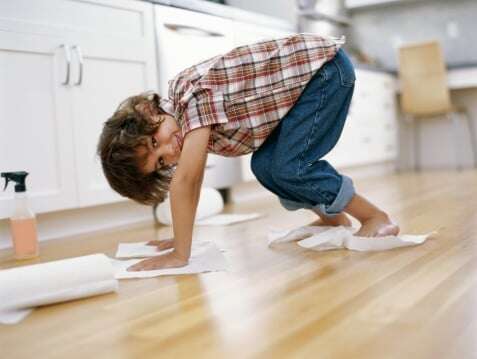 We clean our hands with soap, wash our hair with shampoo and clean our clothes with detergent.
We clean our hands with soap, wash our hair with shampoo and clean our clothes with detergent.
The active ingredient here is soap, so when Experts in Your Home tell a homeowner with a newly installed tile floor that all he or she needs to clean their floor is water, it's no wonder it takes a few rounds of persuasion.
In reality, there is a little more involved in keeping tile flooring looking its best. But when we say “little,” we mean very little. If you haven't fallen in love with your ceramic or natural stone tile floor by now, you will when the Experts reveal how blissfully low maintenance tile flooring really is. Here are our tips on how to clean tile flooring:
Stay on Top of Dust and Dirt
You can get away with cleaning your tile with water alone as long as you remove dust, dirt and crumbs first. So get into the groove by using a broom, dry mop or vacuum on a regular basis. How “regular” depends on your habits and lifestyle. Unless you have a furry pet, you may not have to sweep, dry-mop or vacuum your tile floor every day; an every-other-day cleaning rotation should suffice.
Your goal is to keep the surface clear; while dust, dirt and crumbs look harmless, they can have the same abrasive effect as sandpaper: dulling the surface and eventually eroding the integrity of the tile itself.
If you're going to use a vacuum, inspect the wheels first. Metal and plastic can scratch tile. Whatever you choose as a cleaning tool – even a feather duster on a particularly busy day – this task should take only a few minutes. The Experts consider this fairly low maintenance for the payoff of high-intensity enjoyment.
Watch Water Work its Wonders
With the surface dirt gone, you can let water work its wonders on your tile flooring. Fill a bucket with tepid water, dip a soft mop into the water, wring it out and wipe the floor. If and when the water turns dark, replace it with a fresh batch.
Seeing really is believing – and what you'll see is clean and shiny tile.
If You Must, Use Soap On Stone Tile
Your sweet-and-simple maintenance regimen should serve you well most of the time. But there probably will be times when you see that your floor is dirtier than usual, such as after you host a party with lots of people or even a few people who do not remove their shoes at the door and track dirt all over your floor.
For times like these, use white vinegar on ceramic tile and reach for that trusty standby – soap – for natural stone tile, such as granite, limestone, marble, slate or travertine. Bolster the water in your 1-gallon bucket with:
- 1 cup of white vinegar for ceramic tile
- 1 tablespoon of Murphy Oil Soap for stone tile
Be certain not to confuse these two directives. Soap can cling to ceramic and leave a “fog,” though you can remove it by going over the floor again with water only. In this case, the Experts are trying to save you a step by using white vinegar; it leaves no residue behind. While white vinegar is a terrific cleaning agent, its acidic qualities clash with natural stone. Like lemon juice (which contains citric acid) or commercial cleaners (which can contain hydrochloric or sulfuric acid), it should never be used on natural stone.
Don't Overlook the Grout
Eventually, you probably will need to apply extra elbow grease to the grout on your tile floor. Grout is porous, meaning that it traps dust, dirt, oil and grease. Even a clean tile floor will look dingy if the grout lines are dirty. For this job, sprinkle some baking soda into a small bowl and add enough water to make a paste with a consistency similar to toothpaste. Rub this mixture along the grout lines with a soft rag, let it sit for 30 minutes and then remove it with a wet rag. If the stain persists, do not resort to using a scouring pad or steel wool. Instead, let the baking soda mixture sit for a few hours or even overnight. Given enough time, baking soda also can work wonders.
We like to think the Experts can, too, which is why you should never hesitate to call us with questions about caring for your tile flooring. Our “active ingredient” is active concern for our customers.








